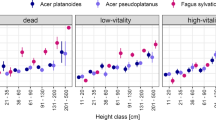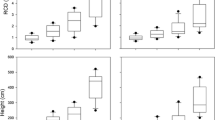Abstract
We surveyed the germination number (N cs) of 2-year and a 1-year survival of Abies sachalinensis and Picea jezoensis seedlings and saplings on 29 fallen logs from 2004 to 2005 in a natural coniferous forest in Hokkaido, northern Japan, in relation to the surface and light conditions of fallen logs. Moss height (H moss), log hardness (Hardness), and the area of fallen log (Area) were measured as the surface conditions by each 1-m block from bottom to top of all fallen logs. The relative photosynthetic photon flux density (rPPFD) 10 cm above the tallest seedling in each block was measured as the light condition. In addition, the height of the tallest seedling or sapling in each block (H max), the difference between a height of each seedling and sapling and the H max (Shading), and a height of seedlings and saplings in 2004 (H ini) were considered. N cs of A. sachalinensis was affected by Hardness and Area, whereas N cs of P. jezoensis was affected by H moss, Hardness, Area, H max, and rPPFD. The survival of seedlings (height < 5 cm) and saplings (5 cm ≤ height < 50 cm) were affected by H ini, rPPFD, and shading for both species. However, the survival of P. jezoensis saplings was more sensitive to decrease in rPPFD and increase of shading than that of A. sachalinensis. Therefore, seedling emergence was influenced by surface conditions, whereas survival was affected by light conditions. Furthermore, P. jezoensis emergence and survival were more sensitive to surface and light conditions than that of A. sachalinensis.



Similar content being viewed by others
References
Asakawa S (1981) The seeds of Japanese trees—Conifer trees (in Japanese). Japan Forest Tree Breeding Association, Tokyo, Japan
Bellingham PJ, Richardson SJ (2006) Tree seedling growth and survival over 6 years across different microsites in a temperate rain forest. Can J For Res 36:910–918
Burnham KP, Anderson DR (2002) Model selection and multimodel inference: a practical information-theoretic approach, 2nd edn. Springer, New York
Christy EJ, Mack RN (1984) Variation in demography of juvenile Tsuga heterophylla across the substratum mosaic. J Ecol 72:75–91
Coates KD (2002) Tree recruitment in gaps of various size, clearcuts and undisturbed mixed forest of interior British Columbia, Canada. For Ecol Manage 155:387–398
Crawley MJ (2002) Statistical computing: an introduction to data analysis using S-plus. Wiley, London
De Steven D (1994) Tropical tree seedling dynamics: recruitment patterns and their population consequences for three canopy species in Panama. J Trop Ecol 10:369–383
Graham RL, Cromack K Jr (1982) Mass, nutrient content and decay rate of dead boles in rain forest canopy gaps. Ecology 78:2458–2473
Harmon ME (1987) The influence of litter and humus accumulations and canopy openness on Picea sitchensis (Bong.) and Tsuga heterophylla (Raf.) Sarg. seedlings growing on logs. Can J For Res 17:1475–1479
Harmon ME (1989) Retention of needles and seeds on logs in Picea sitchensis–Tsuga heterophylla forests of coastal Oregon and Washington. Can J Bot 67:1833–1837
Harmon ME, Franklin JF (1989) Tree seedlings on logs in Picea-Tsuga forests of Oregon and Washington. Ecology 70:48–59
Harvey AE, Jurgensen MF, Larsen MJ, Graham RT (1987) Relationship among soil microsite, ectomycorrhizae, and natural conifer regeneration of old-growth forests in western Montana. Can J For Res 17:58–62
Hett JM (1971) A dynamic analysis of age in sugar maple seedlings. Ecology 52:1071–1074
Hett JM, Loucks OL (1976) Age structure models of balsam fir and eastern hemlock. J Ecol 64:1029–1044
Hiura T, Sano J, Konno Y (1996) Age structure and response to fine-scale disturbances of Abies sachalinensis, Picea jezoensis, Picea glehnii, and Betula ermanii growing under the influence of a dwarf bamboo understory in northern Japan. Can J For Res 26:289–297
Honda S (1926) Recruitment state of natural coniferous forest in Hokkaido (in Japanese). J Jpn For Soc 33:12–31
Iijima H, Shibuya M, Saito H, Takahashi K (2004) The effect of moss height on survival and growth of Picea jezoensis seedlings on fallen logs (in Japanese with English summary). J Jpn For Soc 86:358–364
Iijima H, Shibuya M, Saito H, Takahashi K (2006) The water relations of Picea jezoensis seedlings on fallen logs. Can J For Res 36:664–670
Inokuma T, Aasakawa S (1961) Germination behavior of Picea jezoensis and Picea glehnii seeds (in Japanese with English summary). J Jpn For Soc 43:166–168
Johnson JB, Omland KS (2004) Model selection in ecology and evolution. Trends Ecol Evol 19:101–108
Kitabatake T (2001) The effect of the depth of litter layer and the size of seedlings on the emergence and survival of seedlings (in Japanese). J Jpn For Environ 43:23–26
Kneeshaw DD, Kobe RK, Coates KD, Messier C (2006) Sapling size influences shade tolerance ranking among southern boreal tree species. J Ecol 94:471–480
Kobe RK, Pacala SW, Silander Jr JA (1995) Juvenile tree survivorship as component of shade tolerance. Ecol Appl 5:517–532
Kubota Y, Hara T (1996) Allometry and competition between saplings of Picea jezoensis and Abies sachalinensis in a sub-boreal coniferous forest, northern Japan. Ann Bot 77:529–537
Kubota Y, Konno Y, Hiura T (1994) Stand structure and growth patterns of understorey trees in a coniferous forest, Taisetsuzan National Park, northern Japan. Ecol Res 9:333–341
Lusk CH (2004) Leaf area and growth of juvenile temperature evergreens in low light: species of contrasting shade tolerance change rank during ontogeny. Funct Ecol 18:820–828
Lusk CH, Kelly CK (2003) Interspecific variation in seed size and safe sites in a temperate rain forest. New Phytol 158:535–541
McCullough HA (1948) Plant succession on fallen logs in a virgin spruce-fir forest. Ecology 29:508–513
Mori A, Mizumachi E, Osono T, Doi Y (2004) Substrate-associated seedling recruitment and establishment of major conifer species in an old-growth subalpine forest in central Japan. For Ecol Manage 196:287–297
Nakagawa M, Kurahashi A, Kaji M, Hogetsu T (2001) The effects of selection cutting on regeneration of Picea jezoensis and Abies sachalinensis in the sub-boreal forests of Hokkaido, northern Japan. For Ecol Manage 146:15–23
Nakamura K (1929) Natural Picea jezoensis and Abies sachalinensis forst in Sakhalin experimental forest (in Japanese). J Jpn For Soc 11:187–194
Nakamura T (1992) Effect of bryophytes on survival of conifer seedlings in subalpine forests of central Japan. Ecol Res 7:155–162
Narukawa Y, Yamamoto S (2002) Effects of dwarf bamboo (Sasa sp.) and forest floor microsites on conifer seedling recruitment in a subalpine forest, Japan. For Ecol Manage 163:61–70
Narukawa Y, Iida S, Tanouchi H, Abe S, Yamamoto S (2003) State of fallen logs and the occurrence of conifer seedlings and saplings in boreal and subalpine old-growth forests in Japan. Ecol Res 18:267–277
Natsume S (1985) Studies on the habitat conditions and early growth in the natural regeneration of Picea jezoensis Carr. (in Japanese with English summary). Res Bull Coll Exp For Hokkaido Univ 42:47–107
Niinemets Ü (2006) The controversy over traits conferring shade-tolerance in trees: ontogenetic changes revisited. J Ecol 94:464–470
Pinero D, Martinez-Ramos M, Sarukhan J (1984) A population model of Astrocaryum mexicanum and a sensitivity analysis of its finite rate of increase. J Ecol 72:977–991
R Development Core Team (2005) R: a language and environment for statistical computing. R Foundation for Statistical Computing, Vienna, Austria. http://www.R-project.org
Sack L, Grubb PJ (2001) Why do species of woody seedlings change rank in relative growth rate between low and high irradiance? Funct Ecol 15:145–154
Schupp EW (1995) Seed-seedling conflicts, habitat choice, and patterns of plant recruitment. Am J Bot 82:399–409
Simard MJ, Bergeron Y, Sirois L (1998) Conifer seedling recruitment in a south-eastern Canadian boreal forest: the importance of substrate. J Veg Sci 9:575–582
Sugita H, Nagaike T (2005) Microsites for seedling establishment of subalpine conifers in a forest with moss-type undergrowth on Mt. Fuji, central Honshu, Japan. Ecol Res 20:678-685
Sugita H, Tani M (2001) Differences in microhabitat-related regeneration patterns between two subalpine conifers, Tsuga diversifolia and Abies mariesii on Mount Hayachine, northern Honshu, Japan. Ecol Res 16:423–433
Suzuki E, Ota K, Igarashi T, Fujiwara K (1987) Regeneration process of coniferous forests in northern Hokkaido. I. Abies sachalinensis forest and Picea glehnii forest. Ecol Res 2:61–75
Szewczyk J, Szwagrzyk J (1996) Tree regeneration of rotten wood and on soil in old-growth stand. Vegetation 122:37–46
Takahashi K (1994) Effect of size structure, forest floor type and disturbance regime on tree species composition in a coniferous forest in Japan. J Ecol 82:769–773
Takahashi M, Sakai Y, Ootomo R, Shinozaki M (2000) Establishment of tree seedlings and water-soluble nutrients in coarse woody debris in an old-growth Picea-Abies forest in Hokkaido, northern Japan. Can J For Res 30:1148–1155
Taylor AH (1990) Disturbance and persistence of sitka spruce (Picea sitchensis (Bong) Carr.) in coastal forests of the pacific northwest, North America. J Biogeogr 17:47–58
Yagi K, Hatano K, Watanabe A (1971) Germination behavior of Picea jezoensis seeds, with special reference to natural regeneration of the spruce stand (in Japanese). J Jpn For Soc 53:19–21
Acknowledgments
We thank the members of the Northern Hidaka Forest Office, especially Ken-ya Yamamoto, Sayaka Sano, and Ryoko Moto-oki, for allowing us to work in the plot and for assistance in the field. We also thank the members of the Laboratory of Silviculture, Hokkaido University, for assistance in the field. We are grateful to Nobuhisa Nagami, the Laboratory of Forest Ecosystem Management, Hokkaido University, for the identification of a sedge species within our plot. We also acknowledge two anonymous reviewers for thoughtful and useful comments for improving the manuscript.
Author information
Authors and Affiliations
Corresponding author
About this article
Cite this article
Iijima, H., Shibuya, M. & Saito, H. Effects of surface and light conditions of fallen logs on the emergence and survival of coniferous seedlings and saplings. J For Res 12, 262–269 (2007). https://doi.org/10.1007/s10310-007-0012-1
Received:
Accepted:
Published:
Issue Date:
DOI: https://doi.org/10.1007/s10310-007-0012-1




